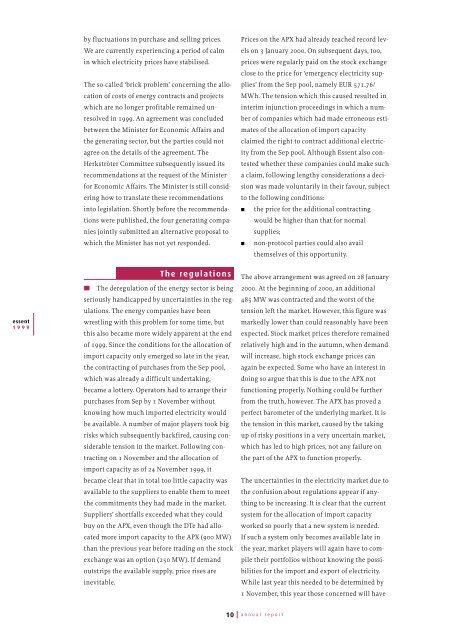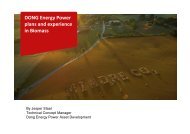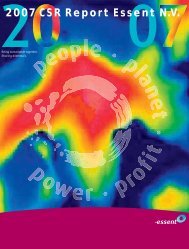Annual Report 1999739KB - Essent
Annual Report 1999739KB - Essent
Annual Report 1999739KB - Essent
You also want an ePaper? Increase the reach of your titles
YUMPU automatically turns print PDFs into web optimized ePapers that Google loves.
y fluctuations in purchase and selling prices.We are currently experiencing a period of calmin which electricity prices have stabilised.The so-called ‘brick problem’ concerning the allocationof costs of energy contracts and projectswhich are no longer profitable remained unresolvedin 1999. An agreement was concludedbetween the Minister for Economic Affairs andthe generating sector, but the parties could notagree on the details of the agreement. TheHerkströter Committee subsequently issued itsrecommendations at the request of the Ministerfor Economic Affairs. The Minister is still consideringhow to translate these recommendationsinto legislation. Shortly before the recommendationswere published, the four generating companiesjointly submitted an alternative proposal towhich the Minister has not yet responded.Prices on the APX had already reached record levelson 3 January 2000. On subsequent days, too,prices were regularly paid on the stock exchangeclose to the price for ‘emergency electricity supplies’from the Sep pool, namely EUR 571.76/MWh. The tension which this caused resulted ininterim injunction proceedings in which a numberof companies which had made erroneous estimatesof the allocation of import capacityclaimed the right to contract additional electricityfrom the Sep pool. Although <strong>Essent</strong> also contestedwhether these companies could make sucha claim, following lengthy considerations a decisionwas made voluntarily in their favour, subjectto the following conditions: the price for the additional contractingwould be higher than that for normalsupplies; non-protocol parties could also availthemselves of this opportunity.essent1999The regulations The deregulation of the energy sector is beingseriously handicapped by uncertainties in the regulations.The energy companies have beenwrestling with this problem for some time, butthis also became more widely apparent at the endof 1999. Since the conditions for the allocation ofimport capacity only emerged so late in the year,the contracting of purchases from the Sep pool,which was already a difficult undertaking,became a lottery. Operators had to arrange theirpurchases from Sep by 1 November withoutknowing how much imported electricity wouldbe available. A number of major players took bigrisks which subsequently backfired, causing considerabletension in the market. Following contractingon 1 November and the allocation ofimport capacity as of 24 November 1999, itbecame clear that in total too little capacity wasavailable to the suppliers to enable them to meetthe commitments they had made in the market.Suppliers’ shortfalls exceeded what they couldbuy on the APX, even though the DTe had allocatedmore import capacity to the APX (900 MW)than the previous year before trading on the stockexchange was an option (250 MW). If demandoutstrips the available supply, price rises areinevitable.The above arrangement was agreed on 28 January2000. At the beginning of 2000, an additional485 MW was contracted and the worst of thetension left the market. However, this figure wasmarkedly lower than could reasonably have beenexpected. Stock market prices therefore remainedrelatively high and in the autumn, when demandwill increase, high stock exchange prices canagain be expected. Some who have an interest indoing so argue that this is due to the APX notfunctioning properly. Nothing could be furtherfrom the truth, however. The APX has proved aperfect barometer of the underlying market. It isthe tension in this market, caused by the takingup of risky positions in a very uncertain market,which has led to high prices, not any failure onthe part of the APX to function properly.The uncertainties in the electricity market due tothe confusion about regulations appear if anythingto be increasing. It is clear that the currentsystem for the allocation of import capacityworked so poorly that a new system is needed.If such a system only becomes available late inthe year, market players will again have to compiletheir portfolios without knowing the possibilitiesfor the import and export of electricity.While last year this needed to be determined by1 November, this year those concerned will have10annual report







